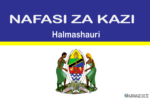AboutMarine Parks and Reserves Tanzania (MPRU)
Marine Reserves encompass distinct areas within the ocean, rivers, natural ponds, and lakes that have been legally designated to establish robust management measures aimed at conserving, preserving, and restoring biodiversity and ecological systems. These measures ensure the sustainable utilization of marine resources, including fish, coral reefs, mangroves, and seagrass.
The conservation of marine areas was initiated in the 1970s through the enactment of the Fisheries Act No. 6 of 1970, with subsequent management falling under the purview of the Department of Fisheries. In 1994, the Government, through parliamentary legislation, enacted the Marine Parks and Reserves Act No. 29 of 1994 (revised in 2009, Chapter 146). This legislation established the Marine Parks and Reserves Unit, responsible for the establishment, management, monitoring, and development of marine reserves.
Presently, the Marine Parks and Reserves Unit oversees 18 marine reserves and protected areas in the Indian Ocean, covering a total area of approximately 2,000 square kilometers. Among these areas, three (3) are designated as Marine Parks, namely Mafia Island, Mnazi Bay and Ruvuma River Estuary (Mtwara), and Tanga Coelacanth Marine Park (Tanga). Additionally, there are 15 designated Protected Areas, including Bongoyo, Sinda, Makatube, Pangavini, Funguyasini, Mbudya, and Kendwa Islands (Dar es Salaam), Maziwe, Kirui, Ulenge, Kwale, and Mwewe (Tanga), as well as Nyororo, Shungimbili, and Mbarakuni (Coast). The selection of these Conservation Areas takes into account the presence of rare biodiversity and critical ecological systems (critical habitats), while aligning with sustainable global conservation objectives (SDG 14/2030).
The Marine Parks and Reserves Unit diligently fulfills its responsibilities in accordance with the Marine Parks and Reserves Act, Chapter 146 of 1994 (revised in 2009).






